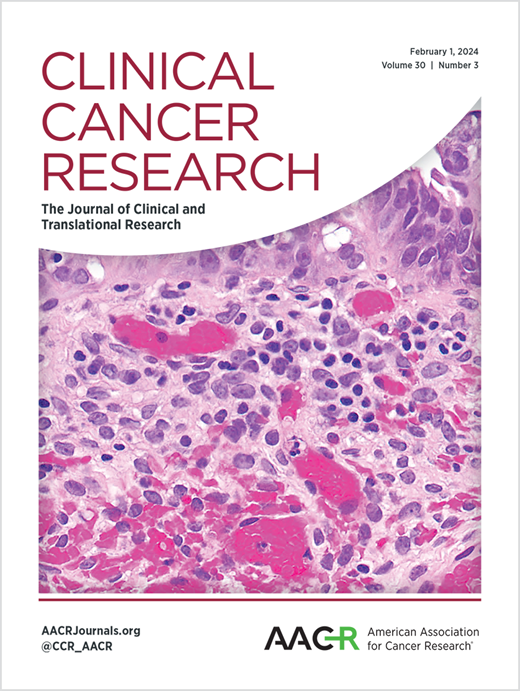Comprehensive single-cell RNA atlas of human laryngeal normal, preneoplastic and tumorigenic states.
IF 10.2
1区 医学
Q1 ONCOLOGY
引用次数: 0
Abstract
PURPOSE The mechanisms driving the progression of vocal cord leukoplakia (VCL) to laryngeal squamous cell carcinoma (LSCC) remain unclear, posing a significant barrier to the effective prevention, early diagnosis, and targeted treatment of LSCC. Therefore, it is essential to characterize the cellular microenvironmental differences between VCL and LSCC at the single-cell resolution. EXPERIMENTAL DESIGN In the study, we conducted single-cell RNA sequencing and spatial transcriptomics on surgical tissue specimens obtained from 36 patients diagnosed with vocal cord polyps (VCP), VCL and LSCC. RESULTS Our study generated the first single-cell atlas of VCP and VCL, while expanding the cancer cell atlas of LSCC. This dataset comprises 318,907 cells and 12,679 spatial transcriptomic spots, allowing the identification of distinct cellular subclusters. We observed that VCL, as a transitional lesion between benign and malignant states, exhibits a hybrid microenvironment that mirrors VCP and LSCC, with early signs of immunosuppressive activity. Immunoregulatory cell populations demonstrate significant gene expression and functional pathway differences between VCL and LSCC. CONCLUSIONS Our scRNA-seq and spatial transcriptomics analyses revealed the cellular heterogeneity underlying benign, precancerous, and malignant laryngeal lesions. We identified epithelial subclusters in VCL with malignant potential and observed shared immunosuppressive features with LSCC, suggesting their role in disease progression. These findings provide valuable insights into the molecular transition from VCL to LSCC and emphasize potential targets for early diagnosis and therapeutic intervention.人类喉部正常、癌前及致瘤状态的单细胞RNA图谱。
目的声带白斑(VCL)向喉鳞状细胞癌(LSCC)发展的机制尚不清楚,这对喉鳞状细胞癌的有效预防、早期诊断和靶向治疗构成了重大障碍。因此,有必要在单细胞分辨率上表征VCL和LSCC之间的细胞微环境差异。在这项研究中,我们对36例诊断为声带息肉(VCP)、VCL和LSCC的手术组织标本进行了单细胞RNA测序和空间转录组学分析。结果本研究首次建立了VCP和VCL的单细胞图谱,同时扩大了LSCC的癌细胞图谱。该数据集包括318,907个细胞和12,679个空间转录组点,允许识别不同的细胞亚簇。我们观察到VCL作为良性和恶性之间的过渡病变,表现出反映VCP和LSCC的混合微环境,具有免疫抑制活性的早期迹象。免疫调节细胞群在VCL和LSCC之间表现出显著的基因表达和功能途径差异。结论scRNA-seq和空间转录组学分析揭示了良性、癌前和恶性喉部病变的细胞异质性。我们在VCL中发现了具有恶性潜能的上皮亚簇,并观察到与LSCC共有的免疫抑制特征,提示它们在疾病进展中的作用。这些发现为从VCL到LSCC的分子转变提供了有价值的见解,并强调了早期诊断和治疗干预的潜在靶点。
本文章由计算机程序翻译,如有差异,请以英文原文为准。
求助全文
约1分钟内获得全文
求助全文
来源期刊

Clinical Cancer Research
医学-肿瘤学
CiteScore
20.10
自引率
1.70%
发文量
1207
审稿时长
2.1 months
期刊介绍:
Clinical Cancer Research is a journal focusing on groundbreaking research in cancer, specifically in the areas where the laboratory and the clinic intersect. Our primary interest lies in clinical trials that investigate novel treatments, accompanied by research on pharmacology, molecular alterations, and biomarkers that can predict response or resistance to these treatments. Furthermore, we prioritize laboratory and animal studies that explore new drugs and targeted agents with the potential to advance to clinical trials. We also encourage research on targetable mechanisms of cancer development, progression, and metastasis.
 求助内容:
求助内容: 应助结果提醒方式:
应助结果提醒方式:


